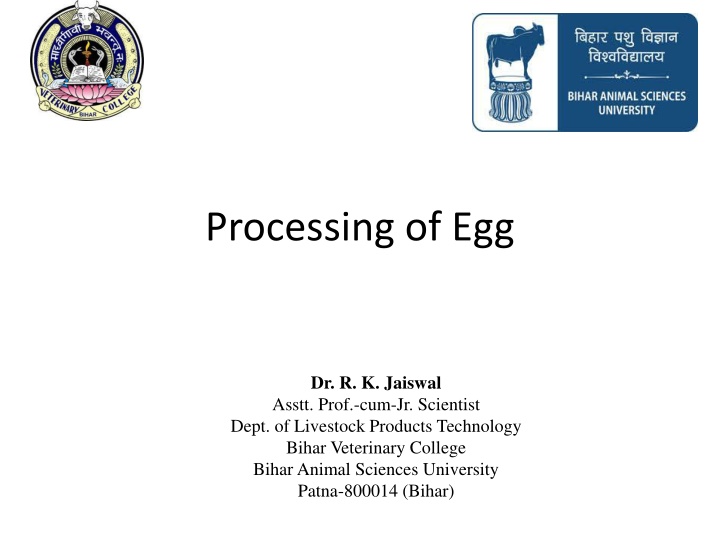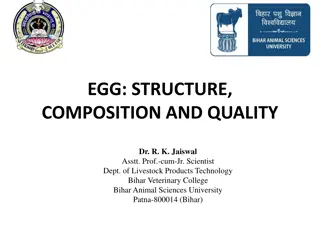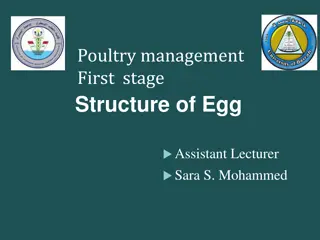Overview of Egg Processing and Functional Properties
Egg processing involves the production of various convenience forms of eggs for commercial, food service, and home use, including refrigerated liquid products, frozen products, and dried or specialty products. The process includes washing, breaking, pasteurization, and classification into different product types. Egg products offer advantages such as convenience, labor savings, and product quality. Additionally, eggs provide desirable functional properties like coagulation, emulsification, and foam formation, making them versatile ingredients in food formulations.
Download Presentation

Please find below an Image/Link to download the presentation.
The content on the website is provided AS IS for your information and personal use only. It may not be sold, licensed, or shared on other websites without obtaining consent from the author.If you encounter any issues during the download, it is possible that the publisher has removed the file from their server.
You are allowed to download the files provided on this website for personal or commercial use, subject to the condition that they are used lawfully. All files are the property of their respective owners.
The content on the website is provided AS IS for your information and personal use only. It may not be sold, licensed, or shared on other websites without obtaining consent from the author.
E N D
Presentation Transcript
Processing of Egg Dr. R. K. Jaiswal Asstt. Prof.-cum-Jr. Scientist Dept. of Livestock Products Technology Bihar Veterinary College Bihar Animal Sciences University Patna-800014 (Bihar)
Introduction Egg products are processed and convenience forms of eggs for commercial, foodservice and home use. These are refrigerated liquid products, frozen products, dried and specialty products. When shell eggs are delivered to the breaking plant, they are put into refrigerated holding rooms. Before breaking, they are washed in water at least 20 degrees warmer than that of the egg and spray-rinsed with a sanitizing agent. They may be moist, but not wet, when they are broken.
Classification of Egg Products Egg is processed to produce convenience forms of eggs for commercial, food service and home uses. Egg products can be classified as follows 1. Refrigerated Liquid products Egg whites, Egg yolk, various blends of Yolk and white 2. Frozen products Egg white, Egg yolk, Salted yolks, Sugared yolks, Whole eggs, Salted whole egg 3. Dried/Dehydrated products Spray dried egg white solids, Instant egg white solids, whole egg or yolk solids, free flowing whole egg or Yolk solids (sodium silicoaluminate added as a free flowing agent).
4. Specialty Products Freeze dried scrambled eggs, Frozen precooked products like Egg patties, Fried eggs, crepes, Egg pizza etc. Egg products are preferred to shell eggs by commercial bakers, food manufacturers and the foodservice industry because they have many advantages including convenience, labor savings, minimal storage requirements, ease of portion control, and product quality, stability and uniformity. As per egg product inspection act, all egg processing plants must follow below conditions: 1. Pasteurization of all egg products is mandatory. 2. Shell eggs used for egg products must be clean and of edible interior quality.
Functional Properties of Egg content Eggs provide many desirable attributes as a food ingredient. The functional properties derived by egg contents are Coagulation, Emulsification and Foam formation. 1 Coagulation The egg protein coagulates upon heating accompanied by binding of moisture and increase in viscosity. Heating causes denaturation of egg protein and gradually aggregates to form a three dimensional gel network. Thus eggs can be used as thickening agent in many food formulations mainly custards, cakes, pie fillings, cream puddings etc. The coagulation temperature is influence by pH, salts, other ingredients and duration of heating. Egg white coagulates at 62 65oC and egg yolk at 65- 70oC. Heat coagulated protein helps to hold the shape of the product in which these are used. Thus eggs are used as binding agent in cutlets, chops etc.
2 Emulsification The phospholipids i.e. lecithin and certain proteins present in egg acts as an excellent emulsifying agent. In mayonnaise egg yolk acts as an emulsifier to keep oil suspended in vinegar. 3 Foaming Eggs when beaten form elastic films, which can trap air. Egg and egg products are good foaming agents. They produce large foam volume and relatively stable for cooking. Thus entrapped air expands during baking and gives fluffy and spongy product. Thus eggs are extensively used as leavening agent in baked products such as cakes and muffins.
Preservation of the Shell Eggs Eggs can be preserved by 4 different methods 1 Wet immersion method In this method only infertile, fresh, good quality eggs should be used 1.1 Lime sealing method In this method saturated solution of lime water is used. Eggs are held in lime water for 14 -16hr, during immersion CO2 released from the egg combined with lime to form calcium carbonate which deposits and seals shell pores. Then it is removed and stored at room temperature. Such eggs can be stored for 3 -4 weeks at room temperature 1.2 Water glass method 10% solution of sodium silicate is commonly called water glass. In this method Water should be boiled and cooled to 24 26oC, to remove the dissolved CO2, before the addition of calculated amount of sodium silicate. Eggs are kept overnight and then removed and stored at room temperature.
2 Dry methods 2.1 Oiling In this method the quality of eggs is preserved by sealing the shell pores using suitable oil and thus evaporation of water, CO2 and other changes. Oiling can be done by Dip method or Spray method. Oiled eggs can be preserved upto 3 weeks at room temperature. 2.2 Gaseous atmosphere Modified atmosphere packing of eggs proved to improve its shelf life. Maintenance of higher CO2 pressure surrounding the eggs prevent CO2 loss from the egg thus improves the egg quality.
3 Thermization or heat treatment methods Fertile, fresh eggs can be preserved by this method. Eggs are thermo- stabilized by immersing it in boiling water for 3 to 5 min while keeping the water stirred constantly. This heat treatment coagulates the albumin very close to the shell and thus prevents CO2 loss. Thermized eggs can be stored at room temperature for 3-4 weeks. 4 Cold storage or refrigeration: Eggs can be stored well for a long time up to 5 6 months at -1.1oC and 85-90% relative humidity. For storage up to 3 4 weeks a temperature of -12.8oC and relative humidity of 60-70% is sufficient.























